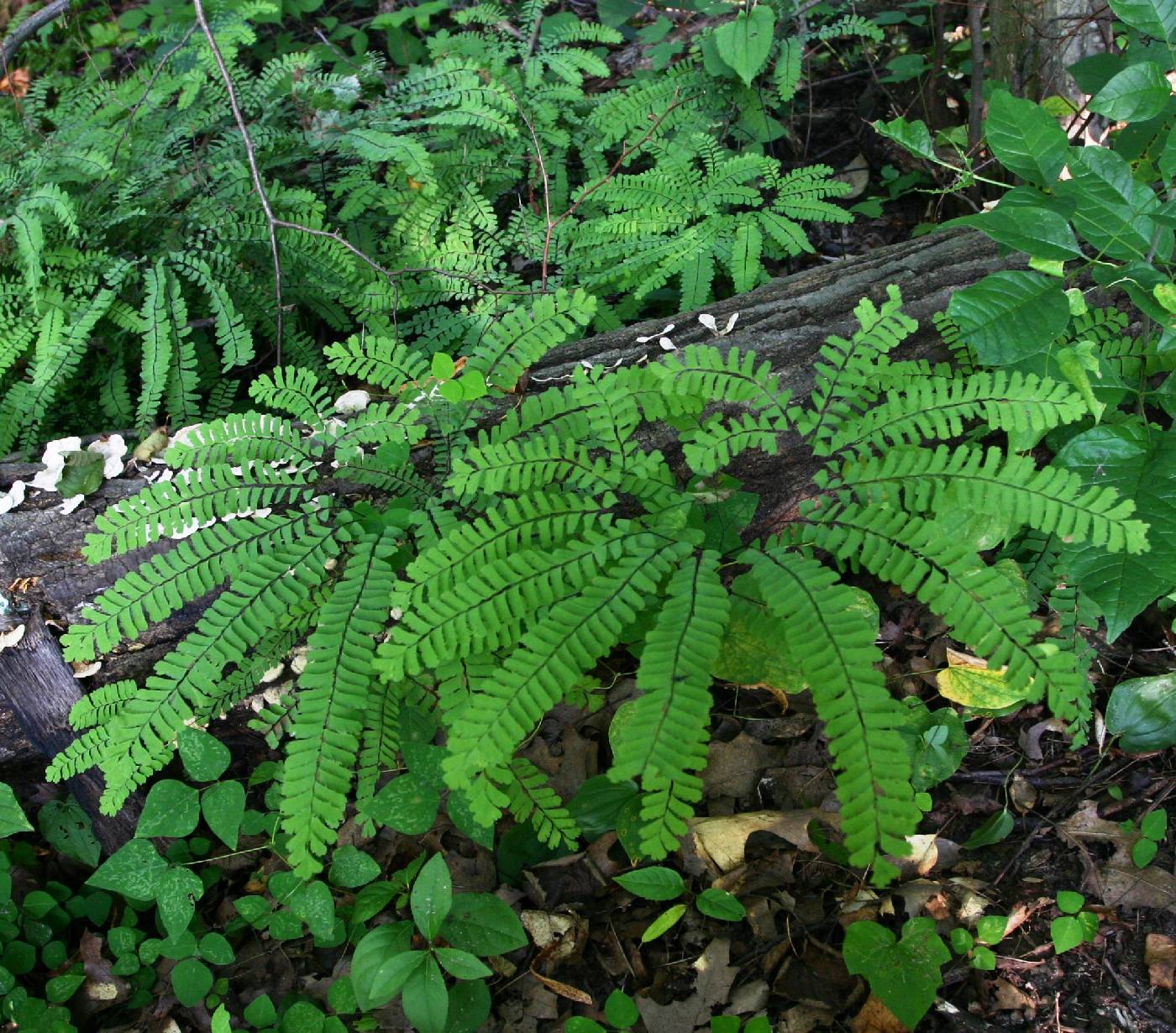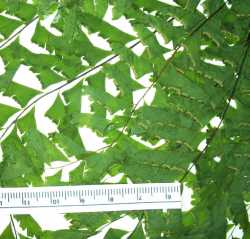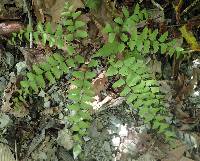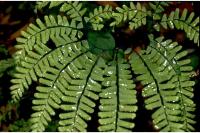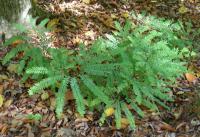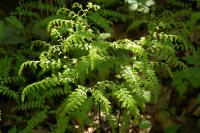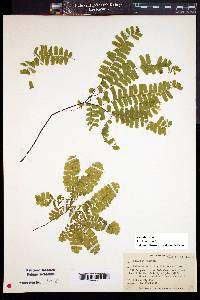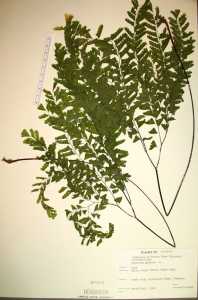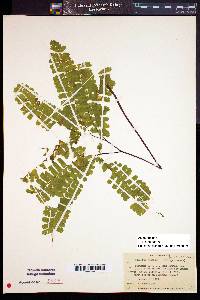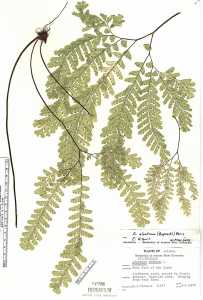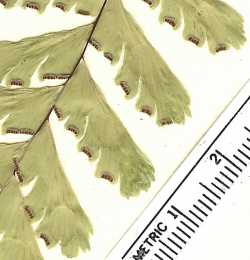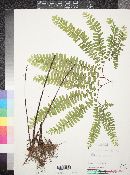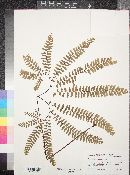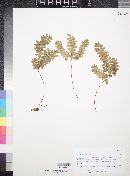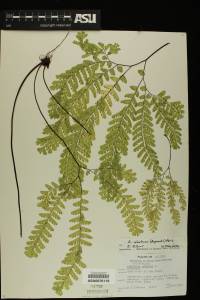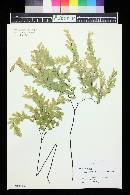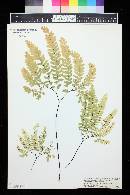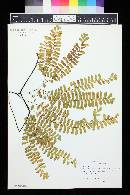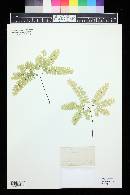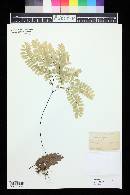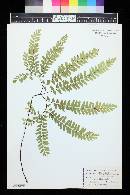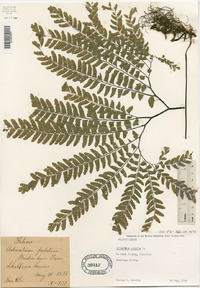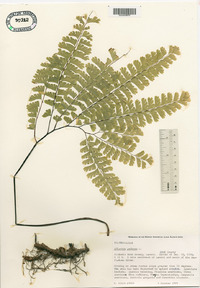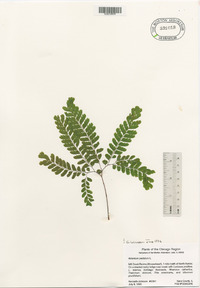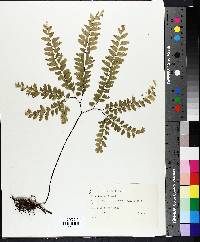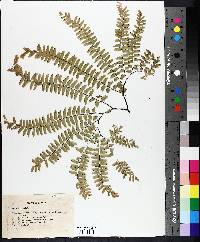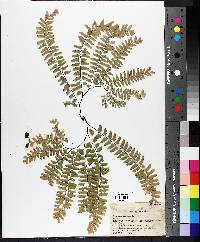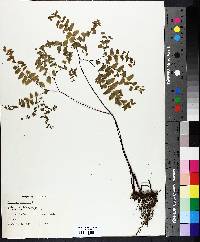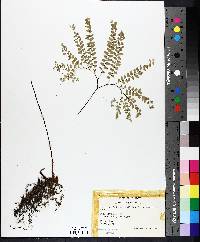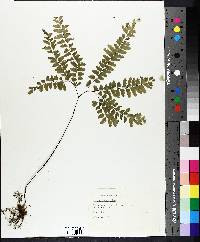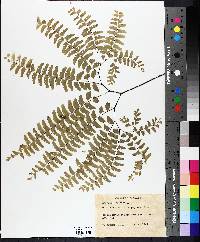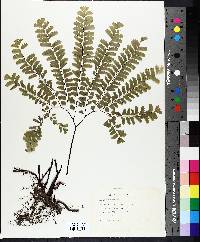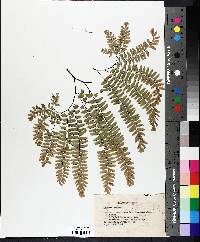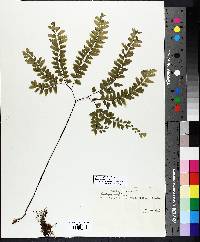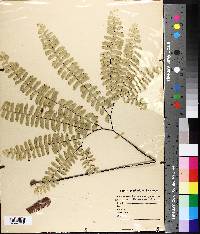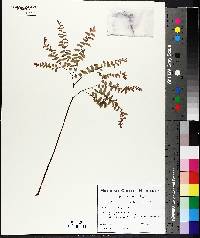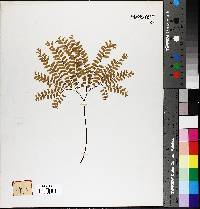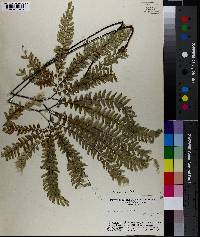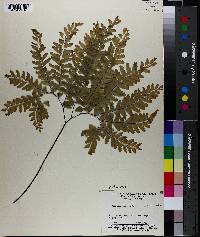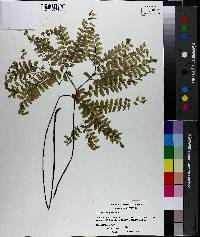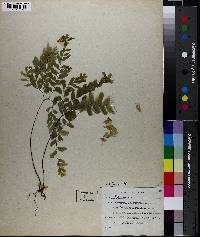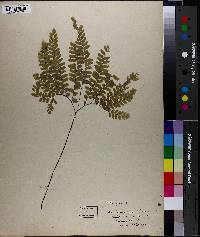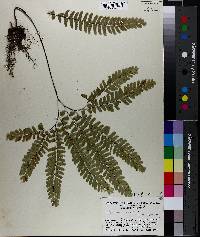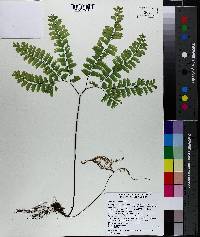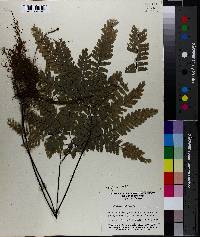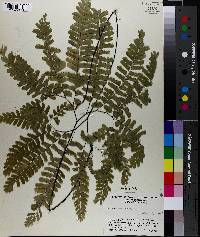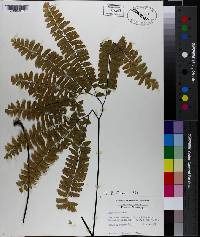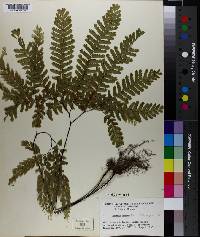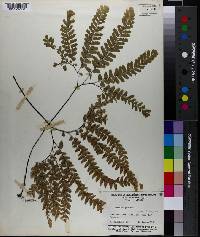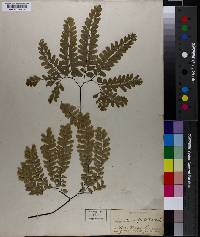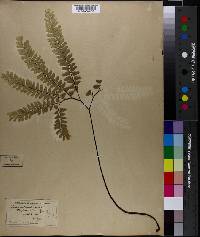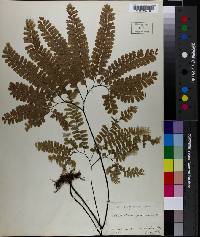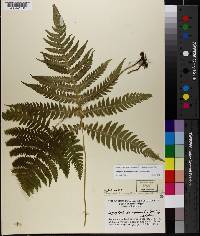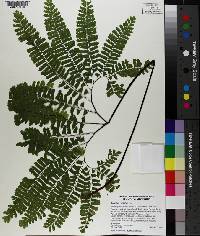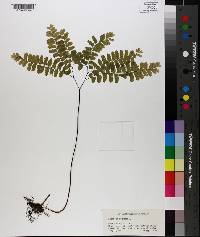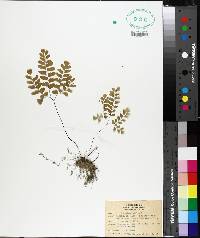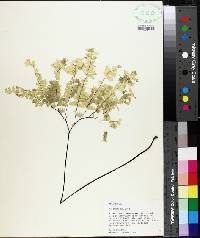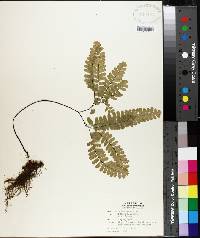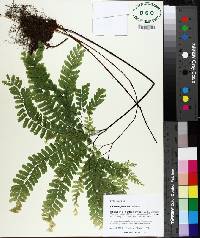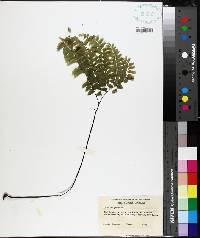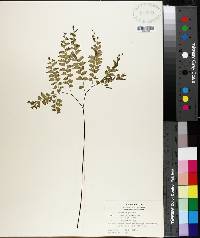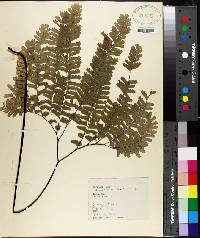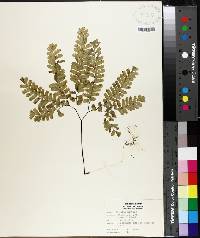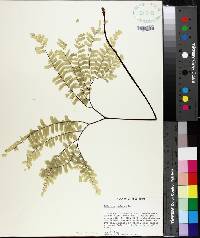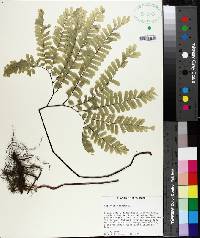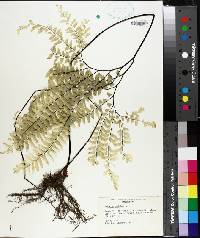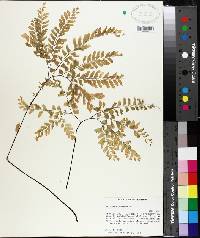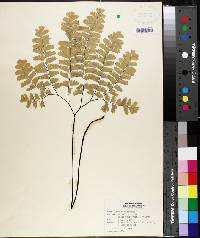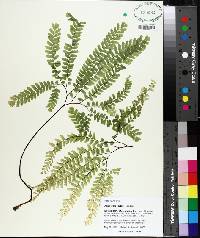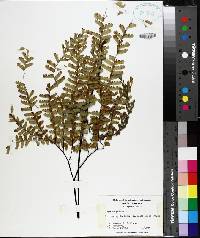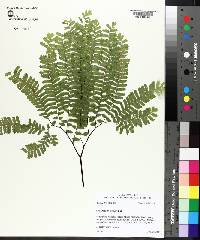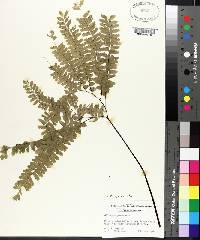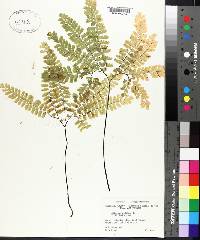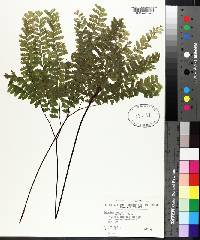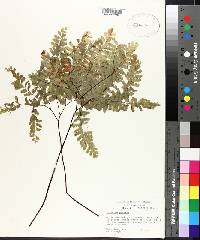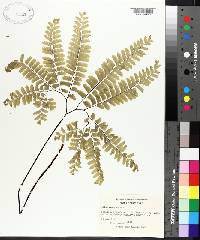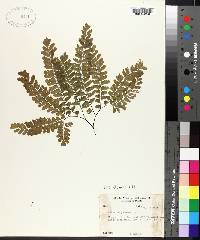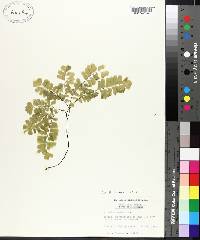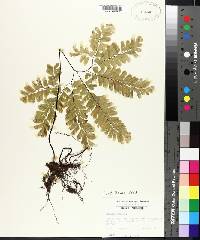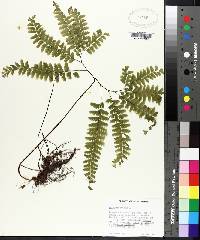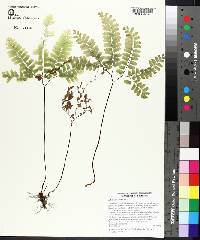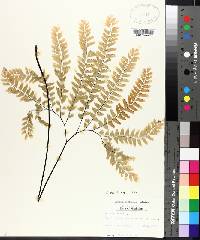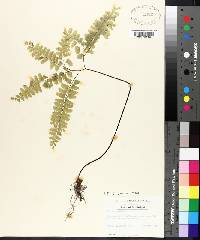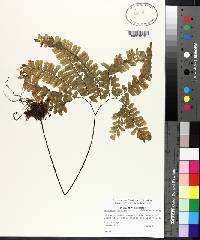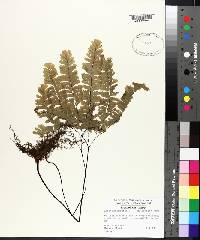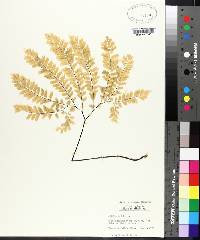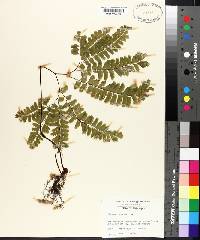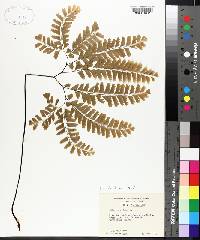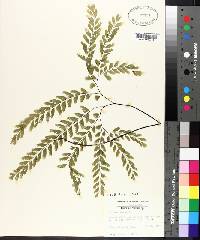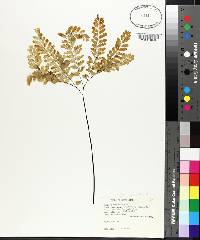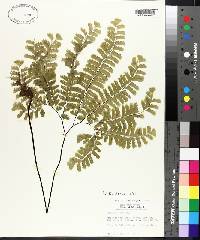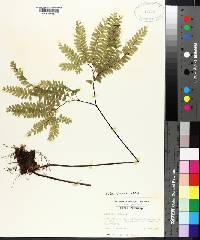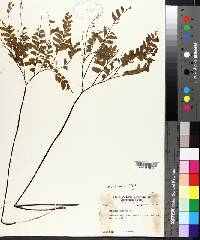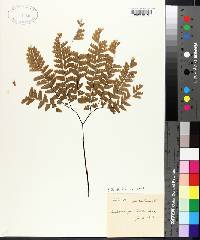
|
|
|
|
Family: Pteridaceae
Northern Maidenhair, more...five-finger fern
[Adiantum pedatum subsp. pedatum, moreAdiantum pedatum var. pedatum] |
Stems short-creeping; scales bronzy deep yellow, concolored, margins entire. Leaves lax-arching (rarely pendent), closely spaced, 40--75 cm. Petiole 1--2 mm diam., glabrous, occasionally glaucous. Blade fan-shaped, pseudopedate, 1-pinnate distally, 15--30 × 15--35 cm, glabrous; proximal pinnae 3--9-pinnate; rachis straight, glabrous, occasionally glaucous. Segment stalks 0.5--1.5(--1.7) mm, dark color entering into segment base. Ultimate segments oblong, ca. 3 times as long as broad; basiscopic margin straight; acroscopic margin lobed, lobes separated by narrow incisions 0--0.9(--1.1) mm wide; apex obtuse, divided into shallow, rounded lobes separated by shallow sinuses 0.1--2(--3.7) mm deep, margins of lobes crenulate or crenate-denticulate. Indusia transversely oblong, 1--3 mm, glabrous. Spores mostly 34--40 µm diam. 2 n = 58. Sporulating summer--fall. Rich, deciduous woodlands, often on humus-covered talus slopes and moist lime soils; 0--700 m; N.B., N.S., Ont., Que.; Ala., Ark., Conn., Del., D.C., Ga., Ill., Ind., Iowa, Kans., Ky., La., Maine, Md., Mass., Mich., Minn., Miss., Mo., Nebr., N.H., N.J., N.Y., N.C., Ohio, Okla., Pa., R.I., S.C., Tenn., Vt., Va., W.Va., Wis. Once considered a single species across its range in North America and eastern Asia, Adiantum pedatum is considered to be a complex of at least three vicariant species ( A . pedatum and A . aleuticum occur in North America) and a derivative allopolyploid species (C. A. Paris 1991). Adiantum pedatum in the strict sense is restricted to deciduous woodlands in eastern North America.
Perennial fern 30 - 80 cm tall Leaves: one or only a few, stalked, somewhat arching, dark green, hairless, 15 - 30 cm long, 15 - 35 cm wide, fan-shaped or almost kidney-shaped in outline, but divided into two, dark purplish black, spreading "branches", which subsequently branch three to nine times further into an almost palmate pattern, with the final sections (pinnae) elongate and further pinnately compound. Rhizome: short-creeping, branched, 3 - 5 mm thick, with light brown to deep bronze-yellow, 3 - 6 mm long, 1 -2 mm wide, somewhat lance-shaped, non-toothed scales. Leaf stalks: closely spaced, erect, dark purple to blackish, 10 - 60 cm long, 1 - 2 mm diameter, wiry but firm, and hairless. Spores: 32 or 64 per sac, yellow or yellowish brown, all of one kind, three-sectioned (trilete), 34 - 40 microns in diameter, somewhat four-angled to rounded, and wrinkled to bumpy or pimply. The spores are released in the summer and early fall, and give rise to the gametophyte (the sexual phase of the plant), which is small, green, inversely heart-shaped to kidney-shaped, hairless, and sits above the ground. Similar species: Adiantum pedatum is quite unlike most of our other fern species in the Chicago Region, but could possibly be confused with Pellaea glabella. However, that species is restricted to habitats with calcareous (usually limestone) cliffs and rocky slopes, the spores are brown to tan, and the leaves are typically much shorter (2 - 40 cm long), more linear or lance-shaped in outline, one to two times pinnately compound with unlobed final segments (pinnules) which have reflexed edges on all sides. The very closely related species A. aleuticum, which occurs in western North America and selected eastern coastal areas, differs by having sharp-pointed angular lobes on the pinnules and these pointed lobes are separated by deep cuts (over 0.5 mm), and the pinnule stalks are usually less than 0.6 mm long. Habitat and ecology: Uncommon, in undisturbed mesic woods. Occurence in the Chicago region: native Notes: In the strict sense, A. pedatum only occurs in rich deciduous woodlands of eastern North America. The closely related A. aleuticum, which occurs in rare coastal environments in eastern North America and more commonly in various habitats of western North America, was once considered a variety of A. pedatum. A third very similar taxon occurs in eastern Asia (Paris 1993). Author: The Field Museum Common Name: northern maidenhair Rarity: None Synonyms: Many, see Tropicos Rhizome short-creeping, 3-5 mm thick, its scales light brown, 3-6 נ1-2 mm; lvs few or solitary, with an erect, purple or purplish-black petiole 1-6 dm, the blade shorter and set nearly at right angles to the petiole, mostly 1-4 dm long and about as wide, or wider, reniform-orbicular when well developed, subequally forked at the top of the petiole into 2 recurved- spreading rachises that bear 2-several progressively shorter pinnae along the outside of the curve; larger pinnae with mostly 15-35 alternate, short-stalked, widely spreading pinnules on each side of the costa; pinnules 12-22 נ5-9 mm, obliquely oblong, the midrib near the lower margin, which is entire and straight or concave, the upper (distal) margin more convex, lobulate, and bearing the oblong indusial flaps; 2n=58, 116. Moist Woods and streamsides in circumneutral soil, and on serpentine slopes at scattered stations from Nf. to Vt.; Nf. to Alas. and adj. Asia, s. to Ga., La., Okla., and Calif. Most e. Amer. plants belong to the nomenclaturally typical phase of the sp.; serpentine plants from both e. and w. N. Amer. tend to have fewer and smaller pinnae and have been segregated as subsp. calderi Cody. Gleason, Henry A. & Cronquist, Arthur J. 1991. Manual of vascular plants of northeastern United States and adjacent Canada. lxxv + 910 pp. ©The New York Botanical Garden. All rights reserved. Used by permission. From Flora of the Indiana Dunes (1930) - Donald C. Peattie A. pedatum L. 2-5 dm. tall, forking at the summit of the rhachises, gracefully recurved; pinnules short-stalked, obliquely triangular, delicately veiny.—Infrequent, in rich cool woods and black loam, Dune Park to Michigan City and eastward. From Flora of Indiana (1940) by Charles C. Deam Infrequent to frequent throughout the state in deep humus in many kinds of soils and with many kinds of associates. It prefers shade and shelter from wind, hence it is most often found in protected places. ...... Indiana Coefficient of Conservatism: C = 7 Wetland Indicator Status: FACU Diagnostic Traits: Frond fan-shaped; leaf stalk and arched-recurved branches dark purple to blackish; leaflets glabrous, delicate; sori along leaflet margins, round to oblong. |

